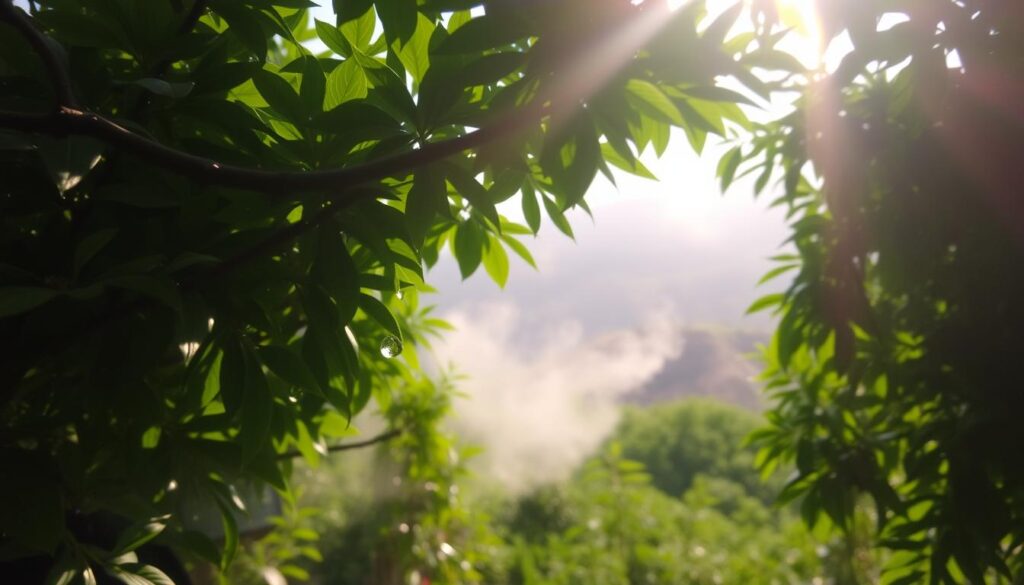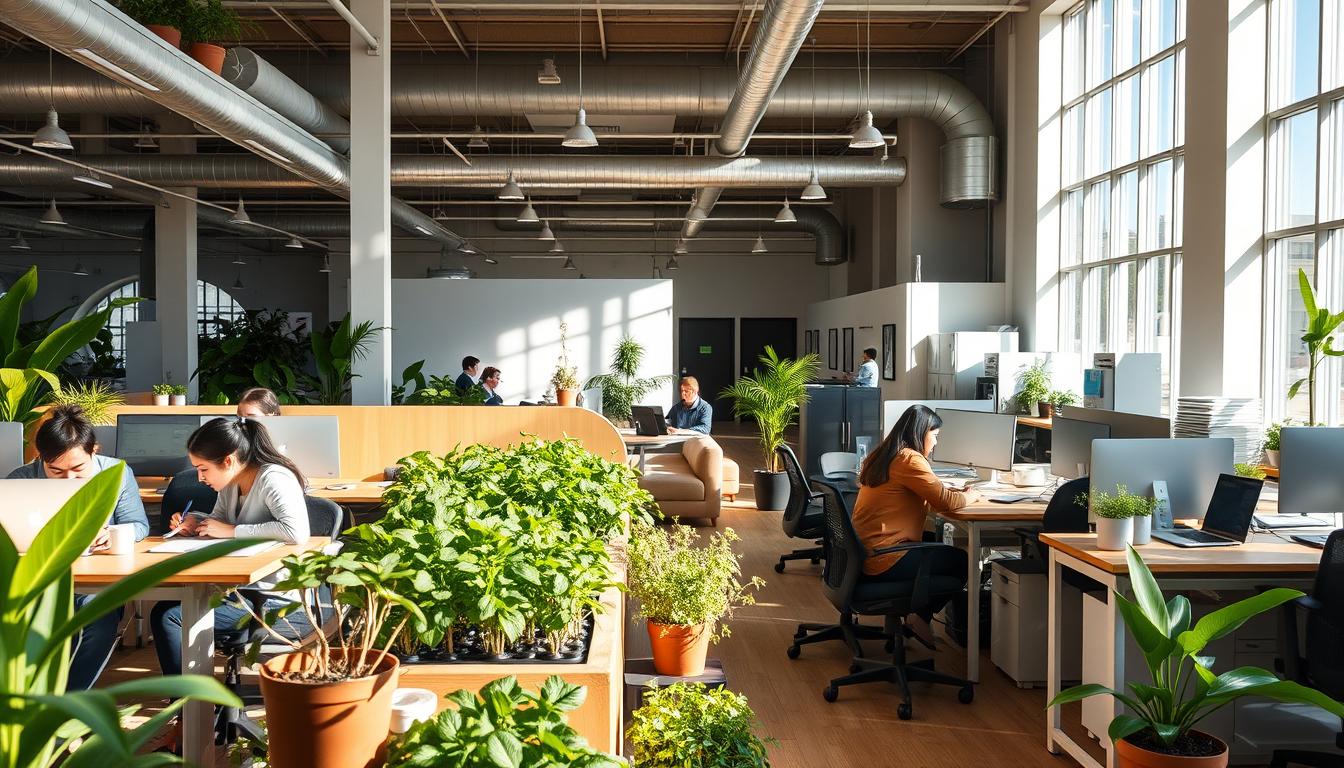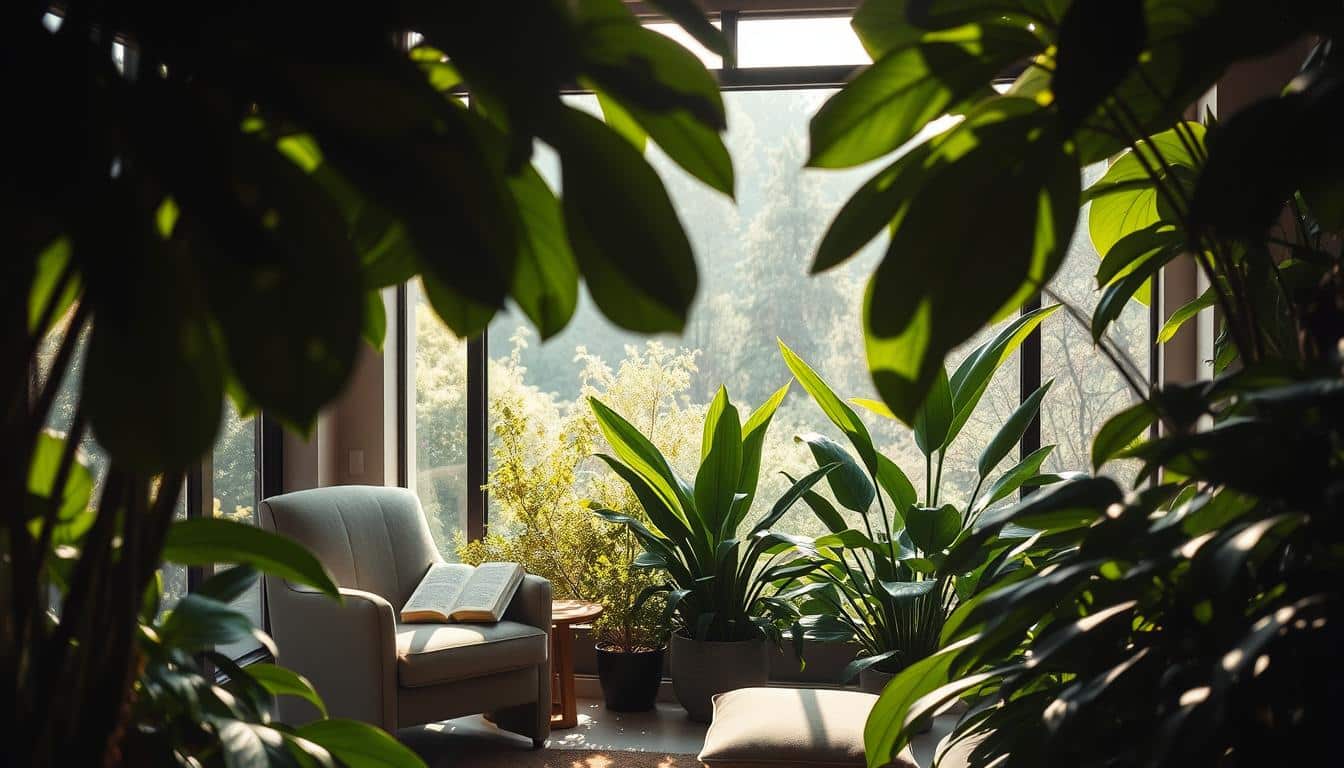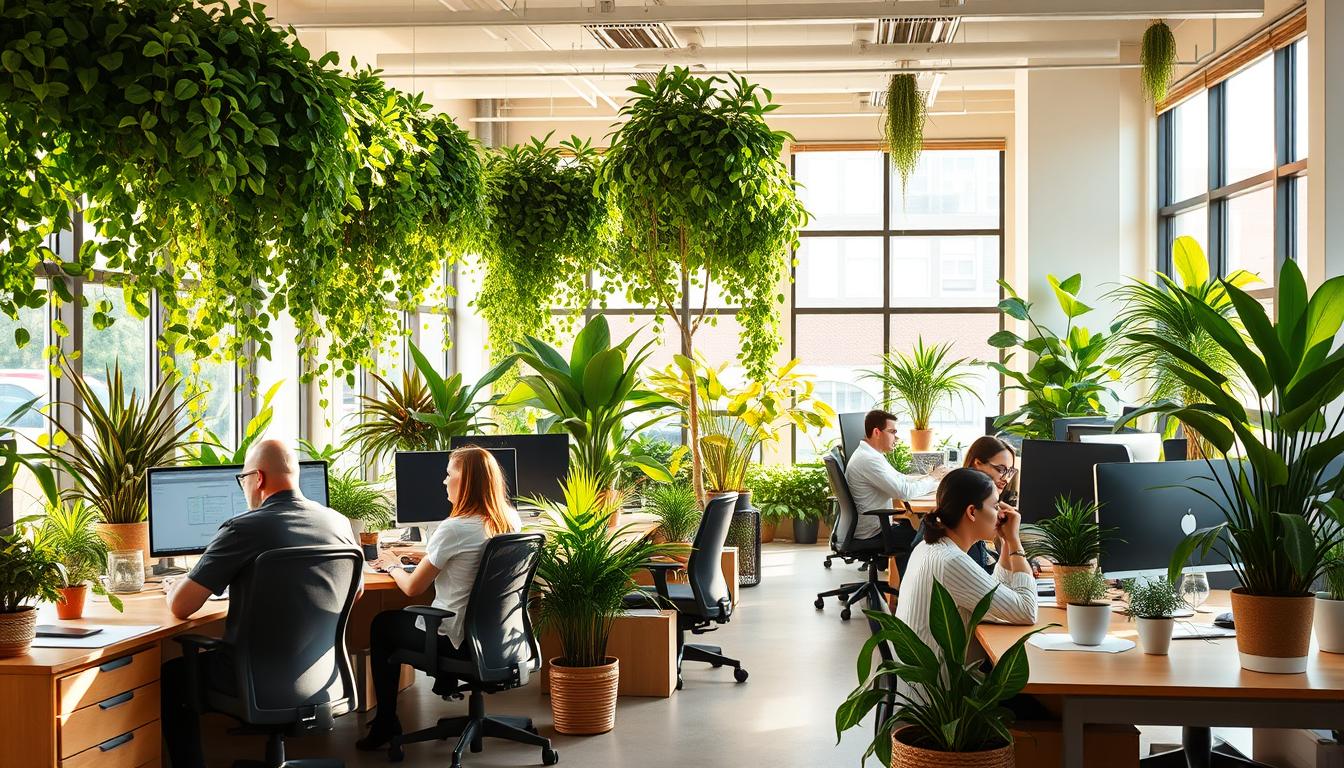Having plants inside helps improve the air we breathe and supports the health of the plants. They add beauty to our spaces while making the air better for us. This is especially true in places where the air tends to be dry. Knowing how plants release moisture helps us see their true value. It shows us the good they do for our surroundings.
Understanding Localized Humidity and Its Importance
Localized humidity is key for keeping indoor plants healthy. It helps them grow by mimicking their natural settings. Knowing about localized humidity is crucial for top plant health.
For most houseplants, the best moisture is between 50-60% RH. But tropical plants need more, around 60-80%. This shows why it’s important to check and change humidity for plant wellness.
Learning about localized humidity helps people make a perfect place for plants indoors. By checking and fixing humidity, your gardening will give better results.

The Role of Transpiration in Plant Health
Transpiration is key for plant health. It is the release of water vapor through leaf pores. This action helps manage moisture inside and outside of the plant. As plants release water, they take more in.
This water absorbs nutrients from the soil. Then, it moves these nutrients to all parts of the plant. This is crucial for making food through photosynthesis.
To grow well, plants need to keep the right pressure in their cells. This pressure comes from water. Without enough transpiration, plants can’t get the water and food they need. This can make them stressed and stop them from growing properly.
Knowing how transpiration works is important. It helps us fix problems with humidity that can affect plant health. So, transpiration is essential for keeping plants healthy.
Localized Humidity from Transpiring Plants
Plants send moisture into the air through a process we call transpiration. This is very important for managing indoor humidity. In places with lots of plants, the moisture they release can really increase the humidity around them. Knowing how transpiration works helps us keep a good atmosphere indoors for plants.
How Transpiration Affects Indoor Humidity Levels
Transpiration naturally increases indoor humidity. As plants lose water, they add vapor to the air, raising moisture levels. This is key in dry areas. Here, plants work harder at transpiring, which could cause them stress if the air is too dry.
Key Factors Influencing Transpiration Rates
Several things impact how fast plants transpire and thus, affect indoor humidity. Important factors include:
- Temperature: Warmer temps speed up plant metabolism and transpiration.
- Light Intensity: More light makes plants transpire more, increasing humidity.
- Relative Humidity Levels: High humidity slows transpiration, while low humidity speeds it up.
Understanding what affects transpiration helps in creating the best indoor setting. This ensures our plants grow well and we can adjust our plant care as needed.
Benefits of Localized Humidity for Indoor Plants
Localized humidity is very important for healthy indoor plants. It helps plants do well in important activities like photosynthesis. The right humidity makes a big difference in plant growth.
Enhancing Growth and Photosynthesis
Plants do better in photosynthesis with enough humidity. High humidity keeps the air moist around plants. This boosts photosynthesis, leading to strong leaves and bright colors.
Reducing Water Stress and Dehydration
Localized humidity also lowers water stress in plants. Plants from tropical areas need high humidity to stay healthy. Without enough humidity, plants can dry out, leading to brown leaves and slow growth. Keeping humidity stable helps indoor plants stay lush.
Optimal Humidity Levels for Different Plant Species
Understanding the right humidity for indoor plants is key for their well-being. Different plants need different moisture levels, like their natural homes. For example, tropical plants like ferns and orchids need humidity over 60%. They need this moisture to keep their leaves green and flowers bright.
On the other side, cacti and succulents like it dry. They do best with humidity between 20% to 30%. They’ve adapted to dry places, which makes them perfect for those who don’t want too much moisture indoors.
Knowing what humidity your plants need helps them thrive indoors. By picking plants that fit the moisture in your home, you make sure they are healthy and last a long time.
Effects of Low and High Humidity on Plant Health
Knowing how humidity levels affect plants is key for their health. Both low and high humidity can stress plants a lot. Spotting these problems early helps keep indoor plants healthy.
Signs of Low Humidity Stress
Low humidity causes certain bad signs in plants. These signs include:
- Brown, crispy edges on leaves
- Wilting or drooping plants
- Slow growth rates
Tropical plants often react faster to low humidity. Spotting these signs quickly lets you take action. You might need to up the moisture or mist the plants.
Indications of Excessive Humidity
Too much humidity also has its issues. Symptoms of high humidity are:
- Yellowing leaves
- Mold growth on soil
- Signs of fungal diseases
These signs can lead to root rot if ignored. Catching them early is crucial. It helps keep plants alive and balance their environment.
Creating a Healthy Indoor Environment for Plants
To make a healthy home for plants, watch the humidity levels. Good care methods boost plant health and growth. These steps help make the air just right for plants to thrive.
Strategies for Increasing Localized Humidity
Here are ways to raise humidity for plants:
- Using humidifiers adds moisture to the air, which is good for plants.
- When plants are close together, they share moisture and help each other stay humid.
- Pebble trays with water give plants steady moisture, helping them grow well.
- Misting plants often keeps the air around them moist.
- Putting plants in humid rooms like kitchens and bathrooms uses the natural wet air there for better health.
These tips help indoor gardeners create the best moist and nurturing setting for plants.
Understanding Relative Humidity’s Role
Relative humidity is very important for indoor plants. It tells us how much moisture is in the air compared to the maximum it can hold at a certain temperature. Knowing this helps us see how water moves through plants and affects their health.
Keeping the right humidity level is key for plants. Too little humidity makes plants lose water fast, which can stress them out. Too much humidity, though, can cause mold. So, controlling humidity helps plants grow well and stay healthy.
Checking humidity levels regularly helps keep plants in good shape. By adjusting for each plant’s needs, we can make sure they do well. Good humidity helps plants make their food better and keeps them strong.
Maintaining Efficient Humidity Levels for Various Plants
To keep indoor plants healthy, you must know the right tools for measuring humidity and understand seasonal changes. With the correct measuring tools, your plants will flourish all year.
Tools for Measuring Humidity
Starting with the right tools is key to managing humidity. Here are some popular ones:
- Hygrometers: Simple devices that provide readings of relative humidity.
- Digital humidity monitors: Often feature integrated temperature gauges for precise climate control.
- Smart home devices: Advanced options that sync with mobile apps, allowing remote monitoring and adjustments.
Adjusting Humidity Based on Seasonal Changes
Changing humidity with the seasons is critical for keeping plants healthy. In winter, indoor heat can dry the air. To help, you can:
- Increase watering frequency to boost humidity around plants.
- Utilize humidifiers to raise ambient humidity levels.
- Rearrange plant placement to ensure they benefit from increased moisture.
Advanced Techniques for Humidity Management
Keeping indoor plants healthy needs good humidity management. Using humidifiers, pebble trays, and putting plants together can boost moisture. This helps plants grow better and stronger.
Using Humidifiers: Pros and Cons
Humidifiers can help a lot in dry areas. They have benefits like:
- Keeping humidity steady, no matter the weather outside.
- Giving better control over moisture, which means less stress for plants.
- They can be set to work automatically, making plant care easier.
But, they also have downsides:
- They can be expensive at first, especially the fancy ones.
- You need to clean them regularly to stop mold and germs.
- Some might be noisy, which could be annoying indoors.
Utilizing Pebble Trays and Grouping Plants
Pebble trays are an easy and cheap way to help with humidity. You just put water and pebbles in a tray. Then, place your plants on top. It’s important for air to move around to work well.
When you put plants close to each other, they help each other stay moist. They release water into the air. This makes a little humid zone that’s good for all the plants near.
Common Plants That Benefit from Localized Humidity
Many indoor gardeners enjoy adding humidity-loving plants to their spaces. These plants do great in moist air. They can make your indoor garden look and feel better.
- Ferns: Ferns love moist air and need it to keep their leaves bright green.
- Orchids: These beautiful flowers do well in wet air. This keeps them healthy and helps them bloom.
- Philodendrons: These are popular plants for inside. They grow well in damp conditions and need water to grow right.
- Calatheas: Known for their unique leaves, calatheas need lots of humidity. This matches the wet climate where they come from.
Picking optimal humidity plants helps your indoor garden flourish. By putting these plants close to each other, you create a special area. This mini-environment is perfect for their growth and makes your place look great.
Challenges of High Humidity and Solutions
High humidity can make plants thrive but it has its problems. Too much moisture can cause fungal infections, root rot, and more pests. You might see leaves turning yellow, mold on the soil, and plants not growing well.
To deal with humidity, you can try a few things:
- Ensure proper ventilation in the space by opening windows or using fans.
- Reduce watering frequency, allowing the soil to dry slightly between waterings.
- Implement fungicides to manage fungal outbreaks before they escalate.
- Group plants based on humidity needs to create a stable microenvironment.
Conclusion
Understanding how plants lose water is key to taking good care of indoor plants. The moisture they release helps both their health and the air quality around us. By knowing what each plant needs and keeping an eye on moisture levels, you can grow strong, beautiful plants.
Humidity is very important for keeping indoor plants healthy. You can use devices like humidifiers or even just arrange your plants thoughtfully to keep the air moist. This not only helps your plants grow but also makes the air better for you.
When you start indoor gardening, remember how important it is to manage moisture. Following humidity management tips can lead to healthier plants. These plants will add beauty and freshness to your home.



